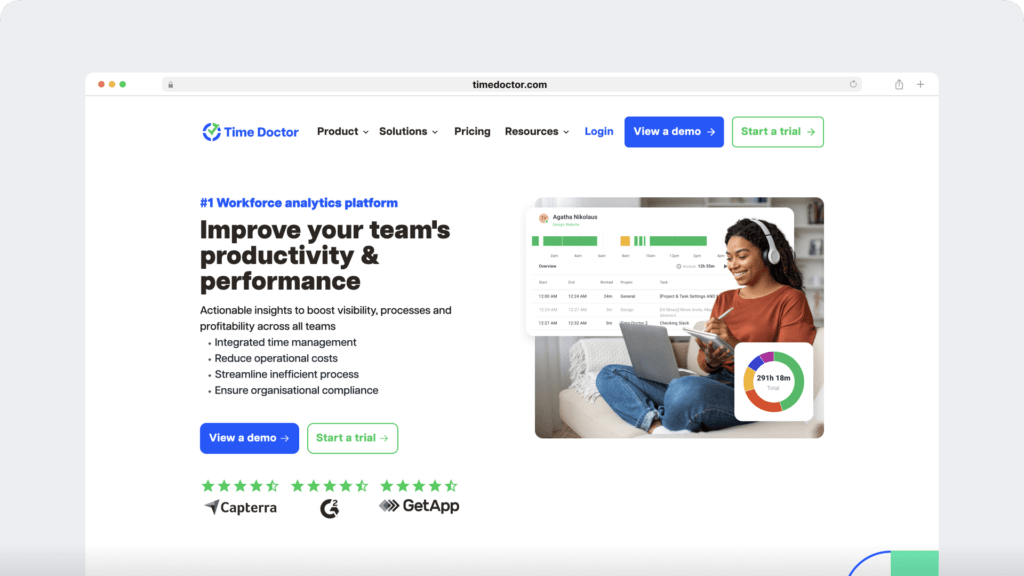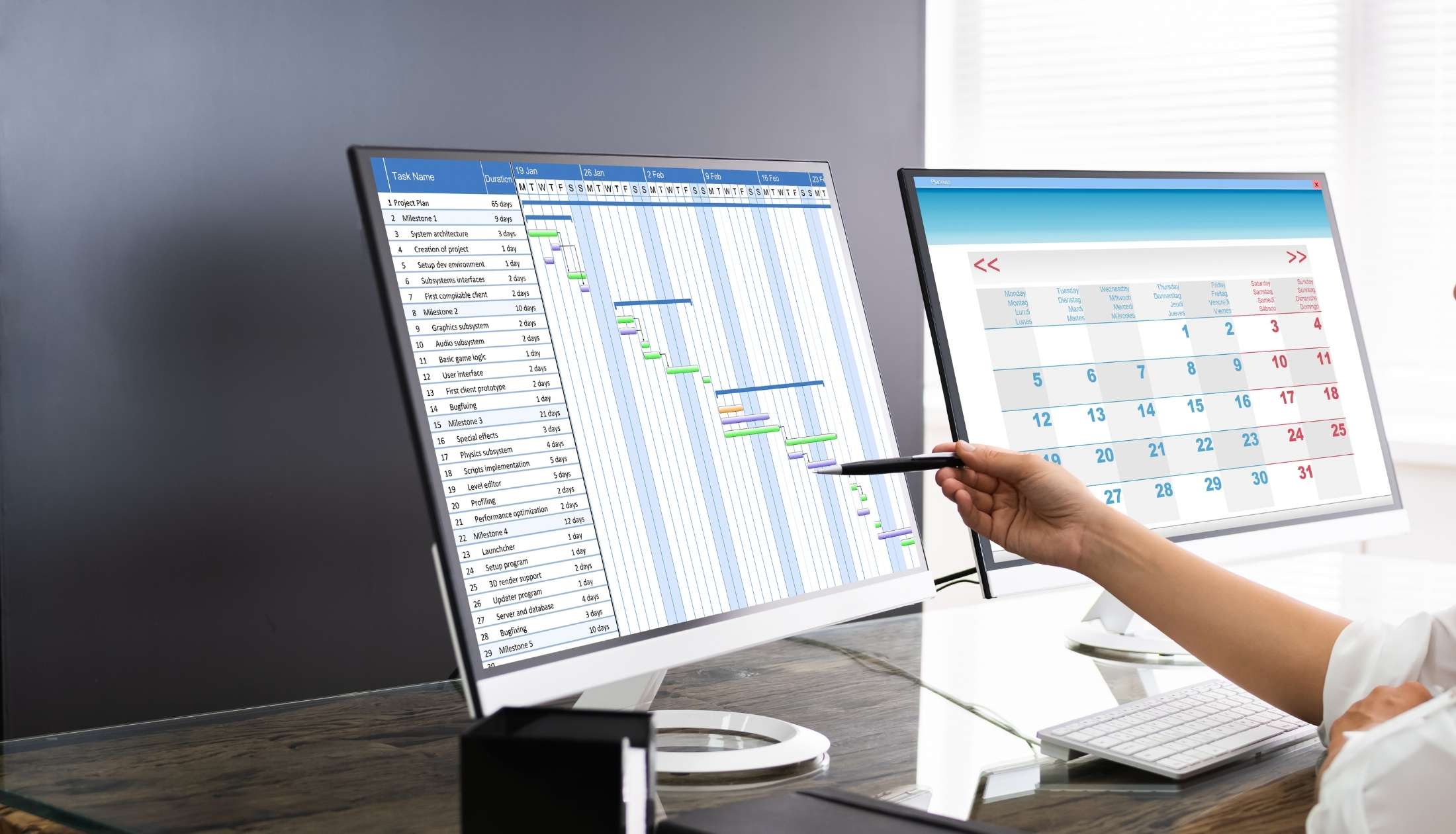4.8K
Have you ever ever seen your workers working lengthy hours however puzzled if they’re actually productive?
Does being “busy” all the time imply being environment friendly? Many companies wrestle with monitoring worker productiveness, particularly when managing distant workers or groups throughout completely different places.
With no clear solution to measure productiveness, how are you aware in case your crew is working effectively or simply spinning their wheels—a query that grew much more related in the course of the pandemic?
Are initiatives taking longer than anticipated on account of bottlenecks, distractions, or inefficient workflows?
Monitoring worker productiveness helps managers observe the period of time spent, determine inefficiencies, and streamline workflows utilizing apps—all with out micromanaging. However how are you going to do that transparently with out creating distrust or making workers really feel like they’re underneath surveillance?
On this information, we’ll break all of it down—the advantages, challenges, and finest instruments for monitoring worker productiveness whereas sustaining belief and motivation.

Desk of Contents
Let’s dive in.
What’s worker productiveness monitoring?
Why do some workers meet deadlines effortlessly whereas others wrestle to finish duties on time?
Monitoring worker productiveness helps companies uncover the explanations behind productiveness gaps, determine inefficiencies, and optimize workflows.
It entails monitoring workers’ work hours utilizing guide strategies, like timesheets and attendance logs, or automated instruments, comparable to worker monitoring software program and time monitoring options. Whereas guide monitoring may be time-consuming and liable to errors, automated instruments present real-time insights that assist enhance effectivity.
For instance, if an worker is assigned 10 duties however solely completes 7, managers want to find out the trigger:
- Was the workload too excessive, or have been distractions a difficulty?
- Did inefficient processes gradual them down?
- May higher useful resource allocation have improved outcomes?
With out clear productiveness knowledge, managers depend on guesswork. However with efficient monitoring, companies can get rid of inefficiencies, enhance activity administration, and improve crew efficiency—all whereas guaranteeing workers really feel supported and their well-being is prioritized, not micromanaged.
How does worker productiveness monitoring differ from surveillance?
Some workers might assume that monitoring worker productiveness is simply one other type of surveillance. This false impression can result in mistrust, decrease morale, and resistance to monitoring instruments. Nevertheless, monitoring and surveillance serve totally completely different functions.
Whereas surveillance focuses on fixed statement and management, worker productiveness monitoring is about gaining insights to enhance effectivity and help workers.
To make clear the variations, right here’s a comparability between worker productiveness monitoring and office surveillance:
Worker productiveness monitoring vs. Office surveillance
| Side | Worker Productiveness Monitoring | Office Surveillance |
| Objective | Improves productiveness, effectivity, and workflow administration | Tracks worker habits for management or safety functions |
| Transparency | Workers are knowledgeable about what’s being tracked and why | Usually carried out secretly with out worker consciousness |
| Focus | Measures work-related actions, comparable to activity completion and effectivity | Displays all actions, together with private actions |
| Influence on Workers | Boosts worker engagement and accountability | Creates mistrust and worry |
| Knowledge Assortment | Tracks productivity-related metrics (e.g., work actions, duties accomplished) | Data private exercise (e.g., keystroke loggings, personal messages, safety footage) |
| Impact on Morale | Encourages self-improvement and efficiency optimization | Lowers morale and may result in resistance from workers |
| Implementation | Makes use of moral instruments with clear insurance policies and worker consent | Usually carried out with out correct communication or consent |
The right way to monitor worker productiveness
In line with One place for World HR, IT, & Finance, monitoring worker productiveness isn’t nearly logging hours—it’s about optimizing effectivity and guaranteeing groups keep centered with out micromanaging. However how can companies do that successfully with out disrupting workflows or shedding worker belief?
Many firms nonetheless use guide exercise monitoring strategies like attendance registers, spreadsheets, and activity logs. Whereas these supply fundamental insights, they’re typically inaccurate and time-consuming. A greater strategy is to make use of automated productiveness monitoring instruments, which offer real-time insights whereas guaranteeing worker privateness.
What can productiveness monitoring software program monitor?
The fitting worker monitoring software program can observe a wide range of productiveness metrics to assist companies achieve clear, actionable insights:
- Log-in and log-out occasions – Tracks whole working hours and identifies attendance patterns.
- Purposes screenshots and web sites used – Distinguish work-related duties from distractions and spotlight time-wasting actions.
- Time spent on duties and initiatives – Helps managers perceive workload distribution and determine inefficiencies.
- Idle time detection – Flags inactivity to cut back unproductive hours and optimize focus time.
- Productiveness analytics – Offers detailed stories on worker efficiency, serving to companies streamline operations and enhance time administration.
Let’s take a more in-depth take a look at the important thing benefits of worker productiveness monitoring.
4 key advantages of monitoring worker productiveness
1. Acquire deeper insights into workflows
Have you ever ever puzzled what time of day your crew works finest? Or which duties take longer than anticipated? Monitoring productiveness helps managers see precisely how workers spend their time, resulting in smarter decision-making and higher useful resource allocation.
By utilizing real-time knowledge, companies can:
- Establish peak productiveness hours to schedule high-priority duties successfully
- Monitor which instruments and platforms workers use most and get rid of pointless inefficiencies
- Alter workflows primarily based on data-driven insights, serving to groups work smarter, not more durable
2. Enhance effectivity and scale back distractions
Distractions are in every single place—electronic mail notifications, social media, pointless conferences. However how a lot time do they really take away from productive work? Worker monitoring software program offers visibility into work habits, whether or not in-office or distant, serving to companies deal with productiveness roadblocks earlier than they have an effect on efficiency.
With productiveness monitoring, companies can:
- Stop time theft and extreme use of non-work-related purposes
- Establish patterns that result in missed deadlines and lowered effectivity
- Assist workers construction their day to cut back pointless distractions
3. Allocate assets successfully
Are your workers overloaded with duties, or have they got time to tackle extra? Productiveness monitoring helps managers steadiness workloads in order that nobody is overworked or underutilized.
For instance, if a crew completes an task in half the estimated time, real-time stories might help managers redistribute duties effectively.
With the appropriate insights, companies can:
- Stop worker burnout by guaranteeing workloads are evenly distributed
- Enhance undertaking administration by assigning duties primarily based on precise efficiency knowledge
- Establish the place further coaching or help could also be wanted to boost productiveness
4. Acknowledge and reward prime performers to spice up productiveness
What motivates workers to do their finest work? Recognition. Workers who really feel valued usually tend to keep engaged, productive, and dedicated to their work. However with out clear productiveness insights, recognizing laborious work turns into a guessing sport.
With worker productiveness monitoring, companies can:
- Establish top-performing workers and acknowledge their contributions
- Inspire groups by fostering wholesome competitors and performance-based incentives
- Assist workers who’re struggling to satisfy productiveness targets, providing steering somewhat than punishment
3 main challenges once you monitor productiveness
1. Workers might lose belief
Would you’re feeling snug in case your employer tracked the whole lot you probably did with out explaining why? In all probability not. The identical applies to workers—belief declines when companies introduce worker monitoring instruments with out transparency.
Some workers fear that monitoring means their each transfer is being watched, making a management tradition as a substitute of motivation. This can lead to:
- Decrease engagement, as workers really feel restricted somewhat than empowered
- Lowered job satisfaction, as monitoring could also be seen as a scarcity of belief
- Elevated stress, as workers really feel pressured to show their productiveness consistently
Answer: Be clear. Earlier than implementing productiveness monitoring software program, clearly talk:
- What knowledge is being tracked, comparable to time on duties and work hours, however not private particulars
- Why monitoring is in place, emphasizing workflow optimization as a substitute of micromanagement
- How workers profit from it, together with higher workload administration, fairer efficiency evaluations, and fewer inefficiencies
When workers perceive the aim of monitoring, they’re extra more likely to see it as a device for enchancment somewhat than surveillance.
2. Privateness considerations and GDPR compliance
Workers might marvel: Is my private knowledge secure? Will my employer see the whole lot I do? Privateness considerations are a significant challenge in worker productiveness monitoring, particularly in distant work and hybrid work environments.
With out clear boundaries, workers might worry that monitoring instruments:
- Monitor private worker exercise, comparable to social media use throughout breaks
- Report delicate info, together with passwords and personal messages
- Function with out consent, violating privateness rules
Past moral considerations, companies should adjust to knowledge privateness legal guidelines comparable to:
- GDPR (Common Knowledge Safety Regulation) in Europe
- HIPAA (Well being Insurance coverage Portability and Accountability Act) for industries dealing with delicate knowledge
- Native labor legal guidelines governing worker rights and office privateness
Answer: Use moral worker monitoring software program that focuses strictly on work-related actions and follows compliance requirements.
- Guarantee monitoring is restricted to enterprise actions, not private knowledge
- Give workers entry to their very own knowledge, permitting them to evaluation their productiveness stories
- Receive written worker consent to adjust to privateness legal guidelines and construct belief
3. Authorized and compliance dangers
Improper worker monitoring can lead to lawsuits and regulatory penalties and would possibly improve insider risk dangers. Many firms implement office surveillance with out totally understanding worker rights and compliance legal guidelines.
Frequent authorized dangers embody:
- Monitoring workers with out consent, which can violate privateness legal guidelines
- Monitoring exercise past working hours, elevating considerations about unpaid extra time
- Unfair or selective monitoring results in potential claims of discrimination
Completely different areas have strict office monitoring legal guidelines, and companies that fail to conform can face authorized motion, monetary penalties, and reputational injury.
Answer: Keep compliant by following finest practices:
- Evaluate native labor legal guidelines earlier than implementing monitoring instruments
- Set up a transparent office monitoring coverage that aligns with rules
- Present written insurance policies that define how knowledge is collected, saved, and used
The ethics of monitoring worker productiveness
The place ought to firms draw the road between moral productiveness monitoring and invasive surveillance?
Whereas monitoring helps enhance effectivity, over-monitoring could make workers really feel watched somewhat than supported. Firms should be certain that monitoring practices are moral, clear, and centered on productiveness—not management.
Why moral monitoring issues
How can firms observe productiveness with out making workers really feel like they’re underneath surveillance? The reply lies in moral monitoring—a apply that prioritizes transparency, equity, and mutual belief.
When used appropriately, exercise monitoring creates a win-win state of affairs for each companies and workers:
| Side | Employer’s Perspective | Worker’s Perspective |
| Objective of Monitoring | Acquire insights to enhance effectivity, get rid of bottlenecks, and help higher time administration. | Desires to optimize their very own productiveness with out feeling consistently watched. |
| Influence on Belief | Desires workers to belief that monitoring is in place for effectivity, not management. | Wants reassurance that monitoring will not be surveillance however a device for help. |
| Impact on Productiveness | Goals to extend productiveness by figuring out workflow inefficiencies and lowering distractions. | Prefers monitoring to be centered on enchancment somewhat than stress to carry out. |
| Transparency | Should clearly talk what’s being tracked and why. | Expects full transparency on monitoring insurance policies and knowledge utilization. |
| Use of Knowledge | Ought to use knowledge to optimize workflows somewhat than to micromanage workers. | Desires monitoring to contribute to honest evaluations and higher work-life steadiness. |
| Worker Morale | Understands that moral monitoring fosters a optimistic work surroundings and engagement. | Feels valued when monitoring is tied to non-public {and professional} development somewhat than punishment. |
Balancing belief and monitoring within the office
How do you make sure that monitoring worker productiveness stays a device for enchancment somewhat than a supply of mistrust? Workers need to really feel trusted, not micromanaged, whereas companies want clear productiveness knowledge to optimize workflows. So, how do you strike the appropriate steadiness?
The important thing lies in communication, transparency, and equity. Workers usually tend to embrace productiveness monitoring after they perceive its objective and the way it advantages them. As an alternative of framing monitoring as a solution to supervise work habits, place it as a device that empowers workers to handle their time successfully, enhance effectivity, and get rid of pointless stress.
Listed here are some methods to keep up belief whereas monitoring employee productiveness:
- Clearly talk what’s being tracked and why – Workers ought to by no means really feel like monitoring is completed in secret. Present a transparent office coverage outlining which metrics are measured, comparable to time on duties, productiveness developments, and undertaking progress, with out invading private privateness.
- Make productiveness knowledge accessible to workers – Giving workers entry to their very own efficiency insights fosters self-improvement. They’ll see the place they’re excelling and the place they might want to regulate their workflow.
- Use monitoring insights to help, not penalize – As an alternative of specializing in idle time detection to catch workers off-task, use productiveness knowledge to determine workflow inefficiencies, steadiness workloads, and enhance crew collaboration.
- Encourage autonomy, not micromanagement – Workers carry out finest after they have management over how they full their duties. Productiveness monitoring ought to information enhancements, not pressure inflexible schedules or extreme oversight.
- Acknowledge and reward productiveness enhancements – Monitoring shouldn’t simply spotlight inefficiencies; it must also have fun achievements. Use efficiency insights to acknowledge prime performers, optimize activity delegation, and guarantee honest efficiency evaluations.
7 ideas for measuring worker productiveness successfully
How do you observe productiveness with out micromanaging? These 7 methods guarantee honest, efficient monitoring whereas preserving workers engaged.
1. Measure outcomes, not simply hours
Worker time spent on-line doesn’t all the time equal productiveness. Deal with outcomes, duties accomplished, and affect somewhat than simply monitoring work hours.
2. Use knowledge for help, not management
Monitoring ought to determine bottlenecks and enhance workflows—not penalize workers. Productiveness insights ought to result in options, not stress.
3. Mix automation with human insights
Studies present numbers, however managers present context. Use monitoring instruments alongside conversations to grasp actual efficiency.
4. Set clear, role-specific targets
Completely different roles require completely different KPIs. A author’s output isn’t measured like a designer’s—customise targets for equity.
5. Let workers entry their very own knowledge
Giving workers visibility into their productiveness stats encourages self-improvement and accountability with out fixed supervision.
6. Deal with patterns, not one-time lows
A foul day doesn’t outline efficiency. Monitor developments over time to identify actual productiveness shifts as a substitute of reacting to every day fluctuations.
7. Acknowledge and reward excessive efficiency
Productiveness monitoring shouldn’t simply repair points—it ought to have fun success. Use knowledge to determine and reward prime performers.
The finest worker productiveness administration software program: Time Physician

Now that we’ve coated the why and the way of monitoring productiveness, you would possibly marvel, what’s one of the best device for the job?
Not all worker monitoring software program is created equal. Some instruments focus an excessive amount of on surveillance, whereas others lack actual productiveness insights. So, how do you discover the appropriate steadiness—the place effectivity meets belief?
Why Time Physician?
Time Physician is among the most trusted productiveness administration instruments as a result of it prioritizes transparency, effectivity, and actionable insights—with out crossing the road into extreme monitoring.
Key Options That Make Time Physician Stand Out
- Correct time monitoring – Monitor work hours with a single click on, offering exact knowledge with out disrupting workflows.
- Idle time detection – Establish distractions and optimize productiveness by detecting lengthy intervals of inactivity.
- Productiveness stories – Acquire priceless insights into worker efficiency, serving to managers make data-driven choices.
- Web site and app utilization monitoring – Perceive which purposes workers use most to make sure time is spent productively.
- Activity and undertaking monitoring – Assign duties effectively and observe time spent on particular initiatives for higher useful resource administration.
- Seamless integrations – Sync Time Physician with undertaking administration instruments like Trello, Asana, Slack, and Jira to streamline the whole lot.
How Time Physician Helps Companies and Workers
Not like conventional monitoring software program specializing in fixed monitoring, Time Physician empowers workers and freelancers—together with distant employees—by giving them entry to their productiveness knowledge.
This permits them to:
- Take possession of their time and self-improve with out feeling micromanaged.
- Establish productiveness bottlenecks and alter their workflow accordingly.
- Steadiness workload distribution and keep away from burnout with smarter time administration.
Time Physician eliminates the guesswork for managers, guaranteeing that choices are primarily based on actual efficiency knowledge, not assumptions.
The way forward for worker productiveness monitoring
How will companies observe productiveness within the subsequent 5 years? Will AI take over, or will workers have extra management over their efficiency knowledge?
As workplaces turn into extra versatile and digital, conventional monitoring strategies are inadequate. Firms are shifting towards moral, AI-powered productiveness monitoring, specializing in outcomes somewhat than surveillance.
What this implies for companies and workers
- For companies: Extra data-driven choices, fewer inefficiencies, and higher workflow administration.
- For workers: Better autonomy, transparency, and self-improvement instruments, lowering considerations about surveillance.
Last ideas
When you might increase your crew member’s productiveness with out making them really feel like they’re being watched, wouldn’t you need to?
Monitoring worker productiveness isn’t about management—it’s about uncovering the actual elements that affect efficiency. Are inefficiencies hiding in plain sight? Are missed deadlines attributable to extreme conferences, unclear priorities, or avoidable distractions?
With no clear monitoring system in place, it’s straightforward for priceless time to slide away unnoticed. However what for those who might pinpoint precisely the place time is misplaced and switch these misplaced hours into significant outcomes?
Time Physician offers you real-time visibility into productiveness developments, serving to you determine workflow gaps, steadiness workloads, and get rid of inefficiencies—with out micromanaging.
Get a demo of Time Physician immediately and begin making each work hour depend.

Liam Martin is a serial entrepreneur, co-founder of Time Physician, Workers.com, and the Working Distant Convention, and writer of the Wall Avenue Journal bestseller, “Working Distant.” He advocates for distant work and helps companies optimize their distant groups.
